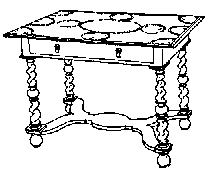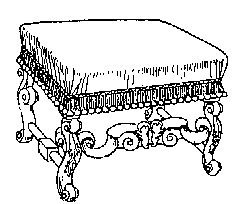William and Mary English Period Furniture
William and Mary 1689-1702
This period was named after the marriage of the English Mary Stuart, the daughter of James II to the Dutch William of Orange.
William & Mary Side Table c. 1680
The Dutch prince brought with him new ideas of comfort for the ordinary person. The furniture in his reign saw the first beginnings of real comfort. Upholstery became common. The chair backs were shaped slightly to fit the shape of your back and the back legs were splayed out at the bottom to prevent the chair from tipping backward.
Bureaux were made strong enough to allow for a bookcase to be added on top for convenience. The Cabriole leg, which is identified with the Queen Anne Period, was borrowed from Holland, which meant the stretcher was gradually phased out.

William & Mary Side Table c. 1680
The King not only imported ideas from Holland, but the craftsmen who left their mark on English Furniture history.
Walnut timber was used for furniture. Oriental lacquer finishes over cheaper timbers became more common. Front fall writing cabinets were developed. Simpler lines with more delicate proportions than before were seen.
Elaborate veneering and marquetry replaced carving – using holly, ebony, satinwood and ivory.

William & Mary Stool c. 1690
Features of William and Mary Furniture
- Upholstery became popular with the stuff over technique.
- The china cabinet was developed to hold the Queens’ hobby, collecting delft and oriental porcelain.
- The bureau with a bookcase was set on stands.
- Back legs matched front legs.
- Feet were simple bun or pear shaped or goat’s hoof.
- First cabriole leg was often left square.
- Legs often connected with x shaped stretchers with a finial at the junction. Stretchers were left flat with a veneered surface.
- Smaller dining rooms changed the emphasis on dining furniture.
- Gateleg tables.
- Flemish Scroll.
- Apart from the bed, bedroom furniture had not yet taken.
- Cabinets, bureaux, day beds, tables and easy chairs were used.
- There was no dressing table: usually a gilded framed mirror hung over the toilet table.
- Tallboys began to develop raised off the unusual stand.
- Inverted cup turning and tapered trumpet.
![]()
Flemish Scroll Leg
More information on Styles and Periods of Interior Decorating
Styles and Periods
Furniture History
Decorating Styles
Period Decoration
What is Style?
